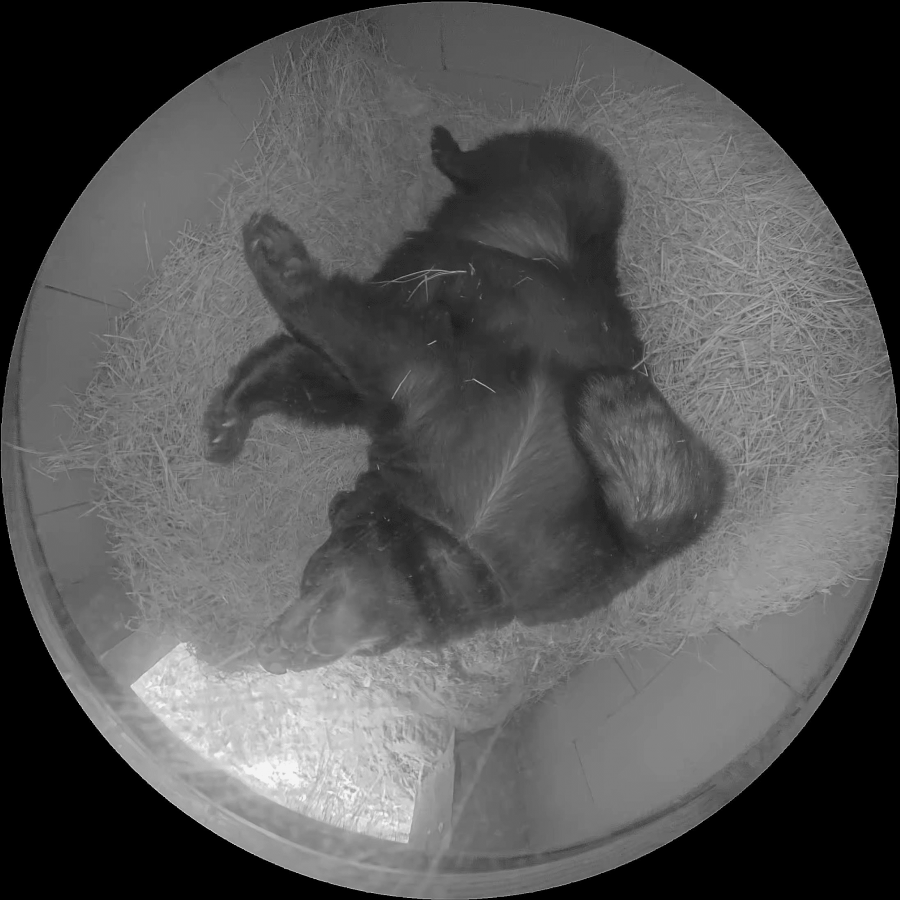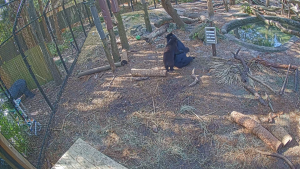

Our camera in Cheyenne’s den has caught her in many adora-bear-ble sleeping positions.
We’ve talked about our three Florida black bears at length, but during the recent winter months you may have noticed less appearances from our bears. That’s because even in Florida, black bears go through a hibernation period, and our bears residents here at the Zoo are no exception. As we enter spring, and our bears start to become more active, we want to walk you through what they’ve been experiencing over the last few months.
Cheyenne
Cheyenne is known for climbing trees and being active during warmer months, but recently she’s been sleeping in her den most of the day. Her cozy den is in a behind-the-scenes area, but she’s been observed snoozing the days away on a camera inside her den. Guests have been able to observe her hibernation via camera outside the bear habitat, and her animal care team has been eyeing the footage to make sure she’s doing okay while tucked away. While Cheyenne is often technically awake and aware of her surroundings, she does not react to stimuli like other times of year.
When hibernation is approaching, there are very clear signs.
“Some of the key features of black bears going through hibernation include decreased heart rate and decreased metabolic rate.” said Animal Wellbeing and Bear Coordinator, Marc Franzen.
Keepers will also start noticing a bear no longer eating, drinking little water, and rarely going to the bathroom, meaning that hibernation time has arrived.
Since Cheyenne has been fully hibernating, her keepers haven’t offered her a prepared diet from our commissary since early December. However, she’s slowly been making her way out of the den in recent days, signaling that her hibernation may be coming to an end soon. Keepers have even been able to check in on how much weight she has lost since early December – over 60 pounds!
While Cheyenne seems like the expert sleeper now, she wasn’t always so keen on tucking herself away for four months at a time. Cheyenne didn’t start showing signs that she was ready to den until about 3 years old.
“The first winter that Cheyenne had access to the bear habitat, she made some effort to dig out under some rocks…Presumably, this was to create a den. From there, we took the cue that we needed to offer safe, stable den sites should she choose to hibernate the following winter,” Marc said.
Betty, being a 2-year-old female bear, hasn’t yet been ready to den. Rather, she’s currently in a state of “walking hibernation.”
Betty
While Betty has access to a safe, warm den, she hasn’t shown too much interest in using it. While she has slowed down quite a bit and takes plenty of long naps, she continues to be active with Brody. This is because we believe she’s now in a state called “walking hibernation.”

Betty and Brody have still been playing with plenty of naps in between.
“Walking hibernation is the period immediately after hibernation during which heart rate and metabolic rate pick up again. In terms of Betty and Brody, we are seeing more instances of play behavior throughout the day…We are also seeing them more consistently consume the lettuces and dandelion greens offered to them,” said Marc.
While Betty didn’t fully hibernate, she did gain lots of weight during hyperphagia, a period of excessive eating, last fall which is an appropriate lead into hibernation. Since then, she has lost 45 pounds, or 20 percent of her body weight. While Betty is still young and learning, we are hopeful she will start to show more hibernation behaviors as she gets older.
“We watched her try to create her own den site several times this winter. It was so amazing watching her just know what to do…. We also believe that Betty is learning from Brody and Cheyenne,” Marc said. “While Cheyenne is comfortably hibernating in a den, Brody has maintained some level of activity. The ability to play every day with Brody is apparently too good to pass up.”
Brody
By this time next year, Betty and Cheyenne may both be beginning to wake up from their periods of hibernation. However, hibernating will always be a bit different for Brody than our females.
During winter, Brody is doing his own version of hibernating. He likes to make several day beds utilizing all the bedding material offered to him by his keepers. It’s typical of male bears, like Brody, to not go to the same extent of hibernating as females do since this is the time cubs are born. In the fall, Brody gained a significant amount of weight too, weighing in at 462 pounds at his heaviest. Since December, he’s been slowly losing his winter weight, having lost 86 pounds to date.
When Does Hibernation End?
While we can guess when Cheyenne will officially wake up for the spring, there is never a designated day for bears to start or end their hibernation. The animal care team must watch the bears and interpret what they are doing, adding the appropriate resources to their habitat at the right time. While it may seem strange for keepers to not feed bears for months at a time, this is a critical part of our bears’ care.
“Minimally feeding animals at the zoo is not normal. Having an animal not defecate for weeks or months at a time is not normal. But for bears it is,” said Marc. “It is still crucial to listen to what they are telling us.”
Brevard Zoo is an independent, not-for-profit organization that receives no recurring government funding for our operating costs. Your generous support enables us to continue to serve our community and continue our vital animal wellness, education and conservation programs.
